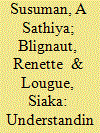| Srl | Item |
| 1 |
ID:
135182


|
|
|
|
|
| Summary/Abstract |
As the world has become more interconnected, the need for coordinated responses to shared global public health threats has increased. A small but growing cadre of diplomats known as health attachés is key among the practitioners of global health diplomacy (GHD) who employ the tools of diplomacy and statecraft to bridge governments’ public health and foreign policy objectives.
|
|
|
|
|
|
|
|
|
|
|
|
|
|
|
|
| 2 |
ID:
135117


|
|
|
|
|
| Summary/Abstract |
As the Ebola virus spreads across Western Africa, World Policy Journal explores the role of social media in tracking epidemics. In order to measure social media’s impact, we compare the number of reported cases and deaths through social media with that of the World Health Organization (WHO), the international body responding to the virus in Liberia, Guinea, and Sierra Leone, in May, June, and July 2014. The information is compiled through Crisis NET, a cutting-edge platform that collects and houses incident data. Crisis NET’s
|
|
|
|
|
|
|
|
|
|
|
|
|
|
|
|
| 3 |
ID:
134241


|
|
|
|
|
| Summary/Abstract |
The problem of disabilities is growing all over the world. Nevertheless, some progress has been made since the year 1981 was proclaimed International Year of Disabled Persons. In 2001 people living with disabilities accounted for 5% of the South African population. Because of their disabilities or the perception society has regarding their potential, this population is mostly economically inactive. This study assesses the relationship between disabilities and the adverse socio-economic impacts. Both descriptive and logistics regression models are used to understand the problem by exploring the data of the 2006 South African General Household Survey. The overall people living with disabilities and aged 15–49 years is estimated at 1742 (961 males and 780 females), when exploring people with disabilities findings reveal that the Western Cape Province’s disabled are mostly affected by physical disabilities (40%). People living with disabilities are 3.5 times (p < 0.01) more likely to suffer from illness/injuries (flu, tuberculosis (TB) and severe cough, diarrhea, blood pressure and HIV/AIDS) than others. Therefore, the study aims to contribute to a better condition of people living with disabilities in South Africa by informing and possibly changing the public perception about them.
|
|
|
|
|
|
|
|
|
|
|
|
|
|
|
|